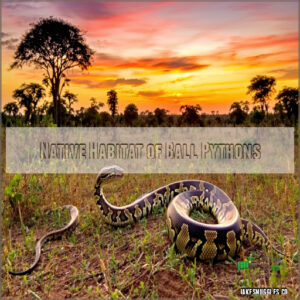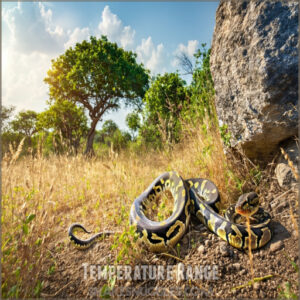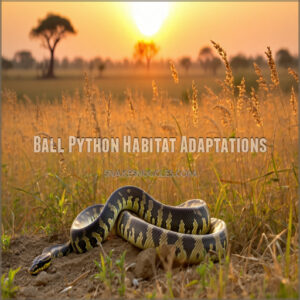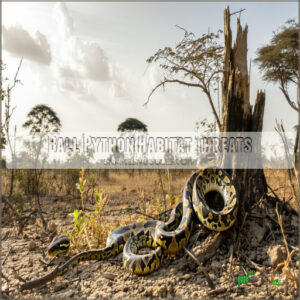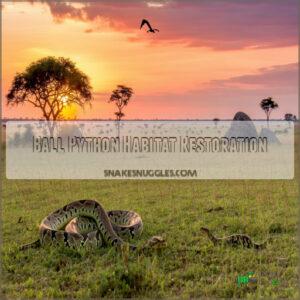This site is supported by our readers. We may earn a commission, at no cost to you, if you purchase through links.
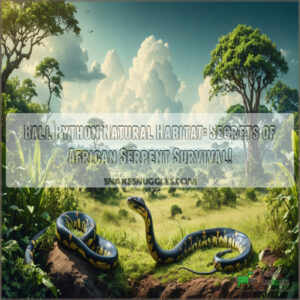 Ball pythons call the savannas and open forests of West and Central Africa home.
Ball pythons call the savannas and open forests of West and Central Africa home.
They inhabit areas where temperatures range from 75-95°F, with humidity levels dancing between 55-80%.
These master survivors are experts at blending into their environment, using dense vegetation as camouflage and protection.
Strategic burrowing sites in rock crevices and tree hollows become their personal safe havens.
They thrive in sparsely wooded areas, utilizing shrub growth and canopy layers to hunt and hide.
But their world is changing—habitat loss threatens their delicate ecosystem, making conservation essential for these remarkable reptiles.
Table Of Contents
- Key Takeaways
- Native Habitat of Ball Pythons
- Ideal Ball Python Natural Habitat
- Ball Python Habitat Characteristics
- Ball Python Habitat Preferences
- Ball Python Habitat Adaptations
- Ball Python Habitat Threats
- Ball Python Habitat Conservation
- Ball Python Habitat Restoration
- Ball Python Habitat Monitoring
- Ball Python Habitat Education
- Frequently Asked Questions (FAQs)
- Where do ball pythons live naturally?
- What is the best habitat for a ball python?
- Where are ball pythons found in the wild?
- Are ball pythons tropical or desert?
- Where do ball pythons naturally live?
- What is the ideal ball python natural habitat?
- Are ball pythons common in the wild?
- How do ball pythons camouflage themselves?
- What are their primary shelter requirements?
- How do they adapt to droughts?
- Conclusion
Key Takeaways
- You’ll find ball pythons thrive in West and Central Africa’s savanna and open forest ecosystems, navigating temperatures between 75-95°F with remarkable adaptability.
- Their survival depends on strategic camouflage and complex habitat interactions, utilizing dense vegetation, rock crevices, and tree hollows as critical protection zones.
- You’ll witness their incredible adaptations, including water-conserving skin, heat-sensing labial pits, and color patterns that make them virtually invisible in their native landscapes.
- Climate change and human activities pose significant threats to ball python habitats, making conservation efforts crucial for preserving these remarkable reptiles’ delicate ecosystems.
Native Habitat of Ball Pythons
Discover the fascinating world of ball pythons, where you’ll explore their native habitats across the lush grasslands and open forests of West and Central Africa.
These remarkable serpents thrive in temperatures ranging from 75-95°F, traversing through diverse landscapes from Senegal to the Central African Republic with remarkable adaptability.
Geographic Range
Serpent cartographers, take note!
Ball pythons sprawl across SubSaharan Africa’s vibrant landscape, mapping a distribution range from Senegal’s western coastline through Ghana and Togo, extending eastward to Sudan and Uganda.
Their native range showcases remarkable habitat connectivity across diverse ecological zones, spanning multiple countries with incredible geographic adaptability.
Understanding their ball python habitat is essential for grasping their survival strategies in the wild, and recognizing the importance of SubSaharan Africa.
Sudanese Subprovince
Mapping the Sudanese subprovince reveals ball pythons’ remarkable adaptability in African wildlife.
These serpentine survivors navigate diverse landscapes with incredible precision:
- Temperature-resilient zones
- Rodent-rich ecosystems
- Strategic hiding networks
West of the Nile, their habitat blends savanna grasslands and sparsely wooded terrain, showcasing nature’s intricate design in regional biodiversity.
To replicate this environment, creating a proper temperature gradient system is essential for their survival and well-being.
West and Central Africa
After exploring the Sudanese Subprovince, your journey continues through West and Central Africa’s ball python habitat.
From Senegal to Sierra Leone, these adaptable predators roam diverse African wildlife landscapes.
Savannah ecosystems provide perfect hunting grounds, with regional climate and terrain features supporting their survival.
These pythons thrive in open forests and grasslands, weaving through native vegetation like living threads of the West African wilderness.
Ideal Ball Python Natural Habitat
If you’re fascinated by ball pythons, you’ll want to understand their ideal natural habitat in the African savannas and open forests.
These remarkable serpents thrive in tropical climates with temperatures ranging from 75-95°F, utilizing grasslands and sparsely wooded areas as their perfect hunting and survival grounds.
Savanna Grasslands
Prowling through African savanna grasslands, ball pythons find their perfect hunting ground.
These open plains teem with rodent prey, offering ideal camouflage and hunting opportunities.
Your scaly friends navigate terrain features masterfully, blending into African grasses with remarkable stealth.
Their survival hinges on understanding these grassland ecosystems – a delicate dance of predation and adaptation in the wild.
The ball pythons’ natural adaptation to savanna habitats plays a pivotal role in their survival and ability to thrive in such African savanna environments.
Open Forests
Traversing open forests, ball pythons find sanctuary among diverse vegetation and abundant prey.
Their adaptable nature allows them to thrive in dynamic ecosystems, expertly utilizing their environment.
They have several strategies for survival, including:
- Exploit dense understory layers for hunting
- Seek refuge in tree canopy’s protective embrace
- Leverage forest floor’s intricate microhabitats
- Adapt to subtle environmental shifts
Their survival hinges on strategic movement and camouflage within these complex, ever-changing wildlands.
To create a similar environment in captivity, understanding the proper temperature gradient zones is vital for replicating their natural habitat.
Tropical Climate
If you’re fascinated by ball pythons, their tropical climate is a wild survival playground.
These serpents thrive in West and Central African savannas where warm temperatures, seasonal rainfall, and diverse vegetation create perfect hunting grounds.
Heat waves and moisture levels drive their reproductive cycles, while unique environmental cues trigger incredible adaptations in these resilient reptiles, making their tropical climate a key factor in their survival.
Ball Python Habitat Characteristics
If you’re fascinated by ball pythons, you’ll want to understand their unique habitat characteristics that help them survive in the wild.
These adaptable snakes thrive in specific environmental conditions, ranging from grasslands to open forests, where temperature, humidity, and vegetation play pivotal roles in their remarkable survival strategy.
Temperature Range
Ball pythons regularly depend on precise thermal zones to regulate their body temperature in the wild.
These remarkable reptiles thrive in specific climate conditions that mirror their African homeland.
- Temperature ranges from 85-95°F during daytime
- Nighttime lows hover between 70-80°F
- Seasonal variations drive natural behavioral patterns
- Strategic heat sources enable critical thermoregulation
Their survival hinges on traversing thermal gradients, using basking spots and cool burrows to maintain ideal physiological balance, which is crucial for their survival in the wild.
They are able to thrive due to their ability to adapt to these conditions.
Humidity Levels
In the scorching African grasslands, your python’s survival hinges on precise water vapor management.
Humidity levels dance between 55-80%, creating perfect atmospheric conditions.
Stagnant water sources and dense vegetation craft humid microclimates, while evaporation rates keep these serpents thriving without inviting fungal threats.
To replicate this environment, understanding optimal humidity levels is essential for creating a thriving habitat.
Vegetation Cover
After checking humidity levels, you’ll find ball pythons thrive in diverse vegetation zones.
From sparse savannas to open forests, these african savannah snakes depend on strategic plant density and leaf coverage.
Shrub growth and canopy layers provide perfect camouflage and shelter, letting these reptiles blend seamlessly into their natural habitat’s intricate forest structure.
These reptiles rely on strategic plant density to survive, and the combination of shrub growth and canopy layers is essential for their survival.
Ball Python Habitat Preferences
You’ll want to understand the unique habitat preferences that help ball pythons thrive in the wild, from their burrowing instincts to their strategic hiding spots.
These African serpents have mastered survival by selecting specific environments that provide shelter, temperature regulation, and ideal hunting conditions across the savannas and open forests of West and Central Africa, which offer them the perfect setup for temperature regulation.
Burrowing Sites
Explore the underground world of ball pythons, where strategic burrowing becomes their ultimate survival tactic.
These savvy serpents expertly navigate complex tunnel systems across African landscapes, seeking refuge in:
- Abandoned termite mounds
- Weathered rodent dens
- Forgotten aardvark excavations
- Hollowed tree foundations
- Rocky subterranean crevices
Their burrow architecture provides critical protection from predators and harsh environmental conditions.
The construction of complex snake burrow systems plays a vital role in the ball python’s ability to thrive in its natural habitat.
Hiding Places
After exploring their burrowing expertise, let’s peek into the domain of ball python hideouts.
These crafty serpents are masters of concealment, transforming rock crevices, tree hollows, and dense underbrush into their personal safe zones.
In the wild, they’ll sneak into log piles, bush dens, and even abandoned mammal burrows or termite mounds.
Whether you’re a snake enthusiast or curious nature lover, understanding these hiding spots reveals how these incredible reptiles stay one step ahead of predators in their challenging African landscapes.
Basking Spots
Basking is a survival strategy for ball pythons, with five essential insights into their thermal world.
- Rock formations provide ideal sun-soaked perches in their natural savannas
- Thermal gradients help regulate body temperature through strategic positioning
- Ideal heat sources range between 90-95°F for metabolic efficiency
- Sun exposure triggers critical physiological processes like digestion and energy conservation
- Carefully selected basking spots support long-term health and reproductive success
Your enclosure’s design should mirror these natural thermoregulation behaviors, creating a habitat that feels like home.
To achieve this, understanding the right temperature gradient zones is essential for creating an ideal ball python habitat setup.
Ball Python Habitat Adaptations
You’ll discover how ball pythons survive in challenging African landscapes through remarkable habitat adaptations like thermoregulation, water conservation, and camouflage.
These serpents have evolved intricate strategies that allow them to thrive in grasslands, savannas, and open forests by masterfully blending physical capabilities with environmental challenges, utilizing camouflage.
Thermoregulation
Ever wondered how ball pythons survive scorching savannas.
Their heat-sensing labial pits are nature’s secret weapon.
These thermal wizards can lower their metabolic rate, allowing nighttime hunting while conserving energy during egg incubation.
By strategically managing body temperature through environmental adaptations, they showcase remarkable survival skills in their challenging ball python natural habitat, utilizing their ability to be thermal wizards.
Water Conservation
Ball pythons are desert survival masters, equipped with water-saving superpowers.
Their impermeable skin acts like a high-tech moisture shield, minimizing evaporative loss during harsh dry spells.
Specialized kidneys concentrate uric acid with remarkable efficiency, while strategic shedding delays help them conserve every precious water droplet in their arid savanna home, utilizing their impermeable skin.
Camouflage
Nature’s master painters, ball pythons wear intricate color patterns that turn them into invisible ninjas of the savannah.
Their adaptive traits blend seamlessly with dry grasses and rocky terrain, creating visual deception that’s both art and survival strategy.
These concealment methods let them vanish from predators’ eyes, transforming texture and shade into their ultimate camouflage shield.
Ball Python Habitat Threats
You’ll be shocked by how human activities are rapidly destroying ball python habitats across West and Central Africa.
As agricultural expansion, deforestation, and urbanization continue to fragment their native grasslands and savannas, these remarkable serpents face unprecedented environmental challenges that threaten their survival.
Habitat Loss
The serpent’s survival hangs in the balance as human impact decimates savanna habitats.
Deforestation causes massive wildlife displacement, shrinking the python’s natural environment.
Agricultural expansion and urban development continuously erode grassland ecosystems, threatening ball python populations.
Sustainability efforts become essential in preserving these remarkable creatures’ remaining territories and ensuring their long-term survival.
Fragmentation
Imagine three distinct ball python populations suddenly cut off from each other by expanding farmlands and urban development.
This habitat fragmentation creates serious challenges, disrupting movement patterns and isolating snake communities.
Smaller, disconnected habitat patches limit food sources, mating opportunities, and genetic diversity, ultimately threatening the species’ long-term survival in the wild.
Degradation
After fragmentation fractures their world, habitat degradation strikes a final blow to ball python survival.
Your favorite snakes face mounting challenges from ecosystem loss:
- Soil erosion destroying burrowing sites
- Land pollution shrinking survival zones
- Forest decline eliminating prey habitats
- Water degradation disrupting ecological balance
- Urban expansion consuming native territories
These factors systematically unravel the delicate web of ball python existence in African savannas , due to habitat degradation.
Ball Python Habitat Conservation
You’re witnessing the critical battle to protect ball python habitats in West and Central Africa, where conservation efforts are more urgent than ever.
By supporting protected areas and sustainable management strategies, you can help preserve these remarkable serpents’ fragile ecosystems and guarantee their survival against mounting environmental challenges, which is crucial for their survival.
Protected Areas
When habitat threats loom large, wildlife reserves become lifelines for ball pythons.
Protected areas like Niokolo-Koba in Senegal safeguard these remarkable reptiles’ homes.
By supporting conservation efforts, you’re helping preserve biodiversity and protect python natural environments.
These sanctuaries aren’t just land—they’re survival blueprints for an entire species.
Sustainable Management
Wildlife guardians, your mission to protect ball pythons starts with smart resource optimization.
By championing sustainable practices, you’ll safeguard these remarkable reptiles.
- Develop strategic captive breeding programs
- Implement rigorous pet trade regulations
- Create ethical conservation frameworks
These green initiatives guarantee genetic diversity while preventing wild population depletion, turning conservation into a powerful environmental governance strategy.
Community Involvement
| Conservation Action | Community Impact |
|---|---|
| Local Volunteers | Protect Ecosystems |
| Research Programs | Preserve Habitats |
| Educational Workshops | Empower Communities |
Ready to save ball pythons?
Your community can become conservation heroes through targeted volunteer programs and local outreach.
Engaging residents near African snake habitats creates powerful environmental stewardship networks that protect these remarkable reptiles’ homes while supporting sustainable wildlife management strategies.
Ball Python Habitat Restoration
When you’re restoring ball python habitats, you’ll need to focus on strategic reforestation, creating essential habitat corridors, and removing invasive species that disrupt their ecosystems.
By implementing these targeted conservation techniques, you’ll help preserve the delicate grassland and savanna environments where these remarkable African serpents have thrived for generations, utilizing methods that ultimately aid in the preservation of their natural habitats through delicate ecosystems.
Reforestation
How can we breathe life back into the ball python’s shrinking world?
Reforestation offers a powerful solution.
- Plant native tree species to restore degraded landscapes
- Create necessary shelter for ball pythons and prey
- Mitigate soil erosion while boosting ecosystem services
Strategic tree planting supports biodiversity, rebuilds the ball python’s natural habitat, and provides critical ecological restoration across West and Central Africa.
Using african tree seeds helps guarantee the successful growth of new flora in these regions.
Habitat Corridors
After reviving fragile savanna landscapes, you’ll weave life-saving Wildlife Crossings that stitch ball python habitats back together.
Strategic Corridor Design creates ecological highways connecting isolated patches.
By linking python territories with vegetated river strips, road overpasses, and habitat stepping stones, you’ll boost population resilience and genetic diversity across their natural African environments, leveraging ecological highways to enhance conservation efforts.
Invasive Species Removal
Wipe out invasive species and give ball python habitats a fighting chance.
Local communities play a pivotal role in alien species control, using targeted eradication methods like mechanical removal and biological intervention.
These exotic pest management techniques protect python wildlife from habitat degradation, ensuring ecosystem balance in savanna territories.
Systematic monitoring and prevention strategies become your best defense against invasive species that threaten ball python survival.
Ball Python Habitat Monitoring
When tracking ball python populations, you’ll need to conduct systematic habitat assessments that map their distribution across West and Central African landscapes.
Understanding these serpents’ ecological patterns requires precise population surveys that analyze habitat conditions, climate change impacts, and environmental shifts affecting their survival.
Population Surveys
After mapping python populations across West Africa, you’ll unravel population trends using strategic census techniques.
Your survey methods track ball python distribution through genetic markers and field observations.
Species density reveals critical insights into their native range, helping researchers decode the survival strategies of these remarkable African serpents.
Understanding the importance of a varied diet, including ball python besides mice options, is essential for their overall health and well-being in captivity.
Habitat Assessments
After tracking ball python populations, researchers zoom in on habitat quality assessment.
You’ll explore their world through a scientific lens by:
- Mapping spatial distribution
- Analyzing ecosystem services
- Identifying wildlife corridors
- Evaluating environmental factors
By understanding ball python natural habitat characteristics, conservationists can pinpoint critical areas needing protection, ensuring these remarkable serpents continue to thrive in their African landscapes.
Climate Change Impacts
After pinpointing habitat patterns, scientists now zoom in on how global warming reshapes ball python survival.
Climate change is rewriting their story across African landscapes.
- Scorching temperatures shrink their comfort zones
- Unpredictable rainfall disrupts breeding rhythms
- Vanishing green spaces challenge their camouflage
- Extreme weather tests their evolutionary resilience
Understanding these shifts helps researchers predict how rising temperatures and carbon emissions will reshape ball python natural habitats, ensuring these remarkable reptiles can adapt and persist in a rapidly changing world.
Ball Python Habitat Education
You’ll uncover the fascinating world of ball python habitats through strategic education initiatives that bridge scientific understanding and conservation awareness.
By learning about their unique ecosystems, you’ll gain critical insights into protecting these remarkable African serpents and their fragile environmental landscapes, particularly through conservation awareness.
Awareness Campaigns
After monitoring ball python habitats, we’re ready to spark change through targeted awareness campaigns.
By leveraging social media, school programs, and community outreach, we’ll shine a spotlight on the ball python’s natural environment.
Our mission is to educate the public about conservation efforts, and the critical role these African serpents play in their fragile ecosystem, including their environmental impact.
Knowledge is power, and together, we can protect their home.
Ecotourism
Discover your inner wildlife explorer through eco-friendly ball python tours.
Responsible Wildlife Tourism lets you witness these remarkable serpents in their natural savannas while supporting Conservation Efforts.
Visit sustainable Eco Lodges, learn about python natural behavior, and contribute directly to protecting ball python habitats.
Your Responsible Visitation guarantees these incredible creatures continue thriving in African landscapes, through sustainable Eco Lodges.
Environmental Education
Want to protect ball python habitats? Your eco-awareness can make a difference!
To start making a positive impact, consider the following steps:
- Learn their unique survival strategies
- Understand their ecosystem dependencies
- Recognize habitat conservation challenges
- Support wildlife preservation efforts
Green living starts with knowledge. By exploring ball python natural behavior and their delicate naturalistic environment, you’ll become a champion for these remarkable reptiles and their sustainable futures. Every small action counts, contributing to a larger movement of wildlife preservation.
Frequently Asked Questions (FAQs)
Where do ball pythons live naturally?
Looks can be deceiving!
Ball pythons naturally inhabit West and Central Africa’s grasslands, savannas, and open forests, thriving in regions like Ghana, Nigeria, and Cameroon.
With temperatures ranging from 75-95°F.
What is the best habitat for a ball python?
You’ll need a spacious enclosure with a heat gradient, hiding spots, and controlled humidity.
Aim for 3-6 square feet, maintain 75-95°F temperatures, provide UVB lighting, and use substrate that mimics their natural grassland environment.
Where are ball pythons found in the wild?
Imagine slithering through West Africa’s lush landscapes. Ball pythons call countries like Senegal, Ghana, and Nigeria home, thriving in grasslands, savannas, and open forests near human settlements.
Are ball pythons tropical or desert?
Ball pythons aren’t strictly tropical or desert dwellers.
They thrive in African grasslands and savannas, adapting to varied environments with moderate temperatures and humidity.
These versatile snakes prefer areas with scattered vegetation and moderate climate conditions.
Where do ball pythons naturally live?
Picture a snake slithering through Ghana’s grasslands at dusk.
You’ll find ball pythons chillin’ in West and Central Africa’s savannas, open forests, and scrublands near water sources, hunting small prey under moonlit skies.
What is the ideal ball python natural habitat?
You’ll thrive in grasslands, savannas, and open woodlands with temperatures between 75-95°F.
Seek refuge in burrows near water sources, enjoying humidity around 50-60% and plenty of hiding spots for your nocturnal adventures.
Are ball pythons common in the wild?
In the vast African wilderness, where survival’s a chess game, ball pythons aren’t just common—they’re strategic survivors.
With widespread populations across West and Central Africa, these adaptable serpents navigate diverse landscapes with cunning resilience.
How do ball pythons camouflage themselves?
You’ll blend in seamlessly with your dark brown, gold-flecked scales.
Your cryptic patterns mimic tree bark and ground textures, making you virtually invisible to predators and prey in African grasslands and woodlands.
What are their primary shelter requirements?
If you stumble upon a ball python’s ideal home, you’ll find they crave secure, snug hiding spots.
These spots mimic their natural camouflage and protection needs.
Underground burrows, dense vegetation, and rock crevices offer perfect shelter.
How do they adapt to droughts?
During dry spells, ball pythons conserve water by reducing activity, seeking underground burrows, and minimizing moisture loss through specialized skin adaptations that help them survive harsh, arid conditions effectively.
Conclusion
Ultimately, understanding the ball python’s natural habitat isn’t just scientific curiosity—it’s a clarion call for conservation.
You’ll find these resilient serpents depend on delicate ecosystems that are rapidly disappearing.
By protecting their savanna and forest homes, you’re not just saving a species, but preserving an intricate web of biodiversity.
Embrace sustainable practices, support habitat restoration, and become a guardian of these remarkable ball python habitats.
Your actions today shape their survival tomorrow.

